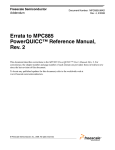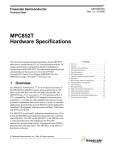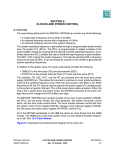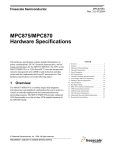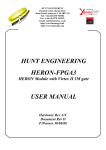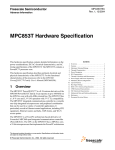Download Designing with the MPC852T App Note
Transcript
Freescale Semiconductor Application Note Document Number: AN2568 Rev. 1, 11/2006 Designing with the MPC852T by Ned Reinhold NCSD Applications Freescale Semiconductor, Inc. Austin, TX The MPC852T is a low-cost member of the MPC866/MPC859T family of communication processors. The MPC852T is manufactured using the high performance HIP6W (0.18 µm) technology, so it can achieve a core frequency up to 133 MHz. The MPC852T incorporates the same microprocessor core and a similar CPM and SIU as the MPC8xx family. The CPM supports two SCCs (SCC3 and SCC4), SMC1, SPI, and a 10/100 Fast Ethernet controller module. The SCCs can support IEEE® 802.3™ Ethernet protocol, but a free microcode relocation patch is needed if SMC and SPI support are required. The SCCs also support HDLC/SDLC, UART, and transparent protocols without the need to relocate the SMC/SPI parameters. The SIU supports two user-programmable machines to control memory devices and peripherals, but the UPWAIT functionality is removed from one UPM (UPM B). The SIU also supports two 16-bit timers, timers 3 and 4, that can be cascaded to form one 32-bit timer. However, there is no support for timer gating because the TGATE1 and TGATE2 pins are removed. The MPC852T does not support the real-time clock or the 32 kHz option for clocking. It operates in only two low-power modes, normal high and normal low. The MPC852T offers superior value in terms of cost, performance, and power consumption to members of the MPC8xx family that are manufactured with pre-HiP © Freescale Semiconductor, Inc., 2003, 2006. All rights reserved. Contents 1 Clocks and PLL . . . . . . . . . . . . . . . . . . . . . . . . . . . . . .2 1.1 System and Bus Clocking . . . . . . . . . . . . . . . . . . . 3 1.2 New PLL Implementation . . . . . . . . . . . . . . . . . . .4 1.3 Clock Module . . . . . . . . . . . . . . . . . . . . . . . . . . . . .4 1.4 DPLL Reset Configuration . . . . . . . . . . . . . . . . . . .6 1.5 Clock and Power Control Registers. . . . . . . . . . . . 7 2 Power Requirements . . . . . . . . . . . . . . . . . . . . . . . . . .12 3 Pins . . . . . . . . . . . . . . . . . . . . . . . . . . . . . . . . . . . . . . .13 3.1 5-Volt Tolerant Pins . . . . . . . . . . . . . . . . . . . . . . .13 3.2 Pinout Description . . . . . . . . . . . . . . . . . . . . . . . .14 3.3 Pin Changes . . . . . . . . . . . . . . . . . . . . . . . . . . . . .15 4 Reset . . . . . . . . . . . . . . . . . . . . . . . . . . . . . . . . . . . . . .16 4.1 Debug Port . . . . . . . . . . . . . . . . . . . . . . . . . . . . . .16 4.2 Memory Controller . . . . . . . . . . . . . . . . . . . . . . . .17 5 Revision History . . . . . . . . . . . . . . . . . . . . . . . . . . . . .17 Clocks and PLL processes and larger geometries. Its phase-locked loop (PLL) clock circuitry is completely redesigned from that of the MPC860. The new digital phase-locked loop (DPLL) eliminates the need for external loop filter components. This combination of communications peripherals makes the MPC852T an ideal choice for a powerful low-end Ethernet router. The MPC850/823 devices offer various levels of integrated support for USB, video, and LCD devices, but because of the reduced feature set, the MPC852T does not implement this support in hardware. The increase in performance and the decrease in cost of the MPC852T often outweigh the additional cost of implementing these features with additional logic. 1 Clocks and PLL The MPC852T clock system provides many clocking options for all internal and external devices. For its clock sources, it contains PLL and crystal oscillator support circuitry. Figure 1 illustrates the internal clock source and distribution that includes the DPLL and interface, clock dividers, drivers, and crystal oscillator. VDDSYN PLPRCR[PDF, MFI, MFN, MFD] PLPRCR[S] DPLL MODCK[1:2] dpdref 1 (PDF + 1) MFN 2 × MFI + MFD+1 Interface Logic (Divide by 1, 2, 4) dpgdck divout1 jdbck ÷2 gclk2 gclk/gclk2 EXTCLK 2:1 MUX csclk gclk1c/gclk2c Low-Power Dividers/ Clock Drivers syncclk CLKOUT Driver tbclk Time Base and Decrementer Driver SCCR[PTSEL] XTAL EXTAL Main Clock Oscillator OSCM 2:1 MUX utpclk brgclk 2:1 MUX (÷ 4 or ÷ 16) SCCR [TBS] gclk1_50/ gclk2_50 CLKOUT tmbclk SCCR[PTDIV] ÷4 ÷ 512 2:1 MUX PIT Clock and Driver pitclk Note: Only CLKOUT is an actual external output; all other outputs are internal signals. Figure 1. Internal Clock Source and Distribution Designing with the MPC852T, Rev. 1 2 Freescale Semiconductor Clocks and PLL 1.1 System and Bus Clocking The PLL circuitry can provide a high-frequency system clock from a low-frequency external source. To enable flexible power control, the MPC852T provides frequency dividers options. It operates at a maximum system frequency of 133 MHz and a maximum external bus frequency of 66 MHz. Table 1 shows the maximum operating frequency and external bus frequency for both the MPC860/855T and MPC852T. Table 1. Maximum Operating Frequency MPC860/855T MPC852T Unit 1:1 Mode 2:1 Mode 1:1 Mode 2:1 Mode Maximum System Frequency 66 80 66 133 MHz Maximum External Bus Frequency 66 40 66 66 MHz To achieve the highest performance, the capacitive loading for the MPC852T external bus must be minimized as much as possible. The SDRAM should be connected directly to the external bus, while isolating and buffering slow access devices, such as flash memory and DRAM with data transceivers. 1.2 New PLL Implementation The MPC852T implements a new DPLL block that eliminates the need for an XFC capacitor. The XFC pin is a no connect (NC) and is not connected internally. The major changes in the clock and DPLL implementation are as follows: • Input clock can only be a 10 MHz crystal at EXTAL/XTAL and/or a 10 MHz or greater oscillator at EXTCLK. • Power-on reset DPLL configuration default value has changed. • The PLL low-power and reset control register (PLPRCR) is used to control the system frequency. This register now has several different fields (MFN, MFD, MFI, and PDF) for the frequency factor calculation. NOTE The PLPRCR is not backward-compatible with the MPC860/MPC855T. For details on the clock and DPLL programming module, refer to Section 1.5.2, “PLL and Reset Control Register (PLPRCR).” 1.3 Clock Module The clock module consists of two external reference sources and a programmable PLL, as shown in Figure 2. Designing with the MPC852T, Rev. 1 Freescale Semiconductor 3 Clocks and PLL Crystal = 10 MHz 0.1 μF 0.1 μF GND EXTAL XTAL OSCM VDD VSSSYN VDDSYN DPLL and Interface Logic EXTCLK VSSSYN1 CKPLPDM CLKOUT Low-Power Divider OSC Figure 2. Clock Module Components 1.3.1 DPLL and Interface The programmable MPC852T DPLL generates the overall system operating frequency in integer and non-multiples of the input clock frequency. The CLKOUT synchronization is not guaranteed for non-integer multiples of OSCLK. If CLKOUT is an integer multiple of OSCLK/EXTCLK, then the rising edge of EXTCLK is aligned (locked/synchronized) with the rising edge of CLKOUT. The phase skew between the rising edges, in this case, lies within a limit of ±3 ns. For a non-integer multiple of EXTCLK, this synchronization is lost, and the rising edges of EXTCLK and CLKOUT have a continuously varying phase skew. Digital implementation of frequency control and loop filtering functions in the design of the DPLL allows the following new features: • Eliminating an on-board loop filter capacitor (XFC), minimization of internal capacitor value. • Selection of frequency and phase/frequency operation modes. • An improved noise immunity, eliminating additional supply and ground pins. • A high frequency resolution with a reduced lock time. • Reduced sensitivity to parameter variations caused be temperature and process. The main purpose of the DPLL is to generate a stable reference frequency by multiplying the frequency and eliminating the clock skew. The DPLL allows the processor to operate at a high internal clock frequency using a low frequency clock input, providing two advantages. First, lower frequency clock input reduces the overall electromagnetic interference generated by the system. Second, the programmability of the oscillator enables the system to operate at a variety of frequencies with only a single external clock source. The OSCLK can be supplied by either a crystal or an external clock oscillator. Crystals are typically less expensive than clock oscillators; however, a clock oscillator has significant design advantages over a crystal circuit, in that clock oscillators are easier to work with, resulting in faster design, debugging, and production. Designing with the MPC852T, Rev. 1 4 Freescale Semiconductor Clocks and PLL The frequency range of OSCLK is 10–160 MHz. Inside the DPLL, OSCLK is divided by the predivision factor (PDF + 1) to generate the DPDREF clock. The frequency range of DPDREF is 10 to 32 MHz. This DPDREF clock is used further inside the DPLL for generating the output clock of the DPLL, the DPGDCK signal. The frequency range of DPGDCK is 160 to 320 MHz. These frequency ranges must be maintained by both the reset configuration settings and the final operating frequency of the DPLL and interface. The interface logic works in three modes depending on divider selection input PLPRCR[S]. The formula for the output frequency of the DPLL and interface logic for each mode is as follows. jdbck = 2 × MFI + (MFN/(MFD + 1)) × for S = 3, reserved. NOTE For synchronization between CLKIN to CLKOUT, the total value by which the CLKIN is multiplied must be an integer. This also requires the total MF factor, that is, [MFI + (MFN/(MFD + 1))] to be an integer as a prerequisite. Table 2 shows the values of the DPLL and interface parameters for typical system frequencies for an input frequency of 10 MHz. Table 2. Typical System Frequency Generation for 10 MHz Input Input Frequency (fref) PDF MFI MFN MFD PLPRCR S[10:11] JDBCK General System Frequency [GCLK2] 10 MHz 0 13 2 9 2 66 33 10 MHz 0 8 0 0 1 80 40 10 MHz 0 9 6 9 1 96 48 10 MHz 0 10 4 9 1 104 52 10 MHz 0 13 2 9 1 132 66 10 MHz 0 15 0 0 1 150 75 10 MHz 0 10 0 0 0 200 100 10 MHz 0 13 3 9 0 266 133 Note: The general system clock [GCLK2] is jdbck divided by 2, and divout1, one of the intermediate signals, is jdbck divided by 2, as DFNH = 0, CSR = 0. 1.4 DPLL Reset Configuration While PORESET is asserted, the reset configuration of DPLL is sampled on the MODCK[1–2] pins. The DPLL immediately begins to use the multiplication factor, pre-division factor values, and the external clock source for OSCLK determined by the sampled MODCK[1–2] pin and attempts to achieve lock. The MODCK[1–2] signals should be maintained throughout PORESET assertion. The mode selection field and various factors are set as shown in Table 3. After PORESET is negated, the MODCK[1–2] values are internally latched, and the signals applied to MODCK[1–2] can then be changed. Designing with the MPC852T, Rev. 1 Freescale Semiconductor 5 Clocks and PLL Table 3. Power-On Reset DPLL Configuration Default at Power-On Reset MODCK[1–2] OSCLK (DPLL and Interface input) General System Frequency (GCLK2) MFI[12–15] PDF[27–30] 00 8 0000 OSCM frequency 40 MHz (for OSCLK frequency = 10 MHz) 01 15 0000 OSCM frequency 75 MHz (for OSCLK frequency = 10 MHz) 10 8 0011 EXTCLK frequency 1:1 mode 11 15 0000 EXTCLK frequency 75 MHz (for OSCLK frequency = 10 MHz) Note: Note: S = 1, MFN = 0, MFD = 1 for all of the reset configurations. The general system clock[GCLK2] is jdbck divided by 2, and divout1 is jdbck divided by 2. NOTE Under no condition should the voltage on MODCK1 and MODCK2 exceed the power supply voltage VDDH applied to the part. At power-on reset, before the PLL achieves lock, no internal or external clocks are generated by the MPC852T, which may cause higher than normal static current during the short period of stabilization. 1.5 Clock and Power Control Registers The following sections describe the clock and power control registers. 1.5.1 System Clock and Reset Control Register (SCCR) The DPLL control register, the system clock and reset control register (SCCR), is shown in Figure 3. This register is affected by HRESET but not by SRESET. Designing with the MPC852T, Rev. 1 6 Freescale Semiconductor Clocks and PLL 0 1 2 3 5 6 7 8 Field — COM — HRESET — # 0 # # # POR 0 0 0 0 * * 9 TBS PTDIV PTSEL CRQEN Field — DFSYNC 20 DFBRG 21 23 15 0 0 0 † 0 0 0 0 † 0 24 DFNL 14 — (IMMR&0XFFFF0000) + 280 19 13 EBDF Addr 18 12 — R/W 17 11 — R/W 16 10 26 DFNH HRESET 0 POR 0 R/W R/W Addr (IMMR&0XFFFF0000) + 282 27 29 DFUTP 30 31 DFAUTP Notes: HRESET is a hard reset and POR is a power-on reset. # The field is undefined. — The field is unaffected. * PTDIV depends on the combination of MODCK1 and MODCK2. PTSEL depends on MODCK1. See Table 14-4, in Chapter 14, “Clocks and Power Control,” of the MPC866 PowerQUICC Family User’s Manual, for more information. † This field is set according to the default of the hard reset configuration word. Figure 3. System Clock and Reset Control Register Table 4. SCCR Field Descriptions Bits Name 0 — 1–2 COM 3–5 — 6 TBS 7 PTDIV Description Reserved, should be cleared. Clock output module. This field controls the output buffer strength of the CLKOUT pin. When both bits are set, the CLKOUT pin is held in the high state. These bits can be dynamically changed without generating spikes on the CLKOUT pin. If the CLKOUT pin is not connected to external circuits, clock output should be disabled to minimize noise and power dissipation. The COM field is cleared by hard reset. 00 Clock output enabled full-strength buffer 01 Clock output enabled half-strength output buffer 10 Reserved 11 Clock output disabled Reserved, should be cleared. Timebase source. Determines the clock source that drives the timebase and decrementer. 0 Timebase frequency source is the OSCLK divided by 4 or 16 1 Timebase frequency source is GCLK2 divided by 16 Periodic interrupt timer clock divide. Determines if the clock, the crystal oscillator, or main clock oscillator to the periodic interrupt timer is divided by 4 or 512. At power-on reset this bit is cleared if the MODCK1 and MODCK2 signals are low. 0 The clock is divided by 4 1 The clock is divided by 512 Designing with the MPC852T, Rev. 1 Freescale Semiconductor 7 Clocks and PLL Table 4. SCCR Field Descriptions (continued) Bits Name 8 PTSEL Periodic interrupt timer select. Selects the crystal oscillator or main clock oscillator as the input source to PITCLK. At power-on reset, it reflects the value of MODCK1. 0 OSCM (crystal oscillator) is selected 1 EXTCLK is selected 9 CRQEN CPM request enable. Cleared by power-on or hard reset. In low-power mode, specifies if the general system clock returns to high frequency while the CP is active. 0 The system remains in low frequency even if the communication processor module is active 1 The system switches to high frequency when the communication processor module is active 10 — Reserved, should be cleared 11–12 — Reserved, should be cleared. 13–14 EBDF 15–16 — 17–18 Description External bus division factor. This field defines the frequency division factor between GCLKx and GCLKx_50. CLKOUT is similar to GCLK2_50. The GCLKx_50 is used by the bus interface and memory controller to interface with an external system. This field is initialized during hard reset using the hard reset configuration word described in Section 11.3.1.1, “Hard Reset Configuration Word,” in the MPC866 PowerQUICC Family User’s Manual. 00 CLKOUT is GCLK2 divided by 1 01 CLKOUT is GCLK2 divided by 2 10 Reserved 11 Reserved Reserved, should be cleared. DFSYNC Division factor for the SYNCCLK. This field sets the divout1, where divout1 is equivalent to JDBCK divided by 2, frequency division factor for the SYNCCLK signal. Changing the value of this field does not result in a loss-of-lock condition. This field is cleared by a power-on or hard reset. 00 Divide by 1 (normal operation) 01 Divide by 4 10 Divide by 16 11 Divide by 64 19–20 DFBRG Division factor of the BRGCLK. This field sets the divout1, where divout1 is equivalent to JDBCK divided by 2, frequency division factor for the BRGCLK signal. Changing the value of this field does not result in a loss-of-lock condition. This field is cleared by a power-on or hard reset. 00 Divide by 1 (normal operation) 01 Divide by 4 10 Divide by 16 11 Divide by 64 21–23 DFNL Division factor low frequency. Sets the divout1, where divout1 is equivalent to JDBCK divided by 2, frequency division factor for general system clocks to be used in low-power mode. In low-power mode, the MPC866 automatically switches to the DFNL frequency. To select the DFNL frequency, load this field with the divide value and set the CSRC bit. A loss-of-lock condition will not occur when changing the value of this field. This field is cleared by a power-on or hard reset. 000 Divide by 2 001 Divide by 4 010 Divide by 8 011 Divide by 16 100 Divide by 32 101 Divide by 64 110 Reserved 111 Divide by 256 Designing with the MPC852T, Rev. 1 8 Freescale Semiconductor Clocks and PLL Table 4. SCCR Field Descriptions (continued) Bits Name Description 24–26 DFNH Division factor high frequency. Sets the divout1, where divout1 is equivalent to JDBCK divided by 2, frequency division factor for general system clocks to be used in normal mode. In normal mode, the MPC866 automatically switches to the DFNH frequency. To select the DFNH frequency, load this field with the divide value and clear CSRC. A loss-of-lock condition does not occur when this field is changed. This field is cleared by a power-on or hard reset. 000 Divide by 1 001 Divide by 2 010 Divide by 4 011 Divide by 8 100 Divide by 16 101 Divide by 32 110 Divide by 64 111 Reserved 27–29 DFUTP 30–31 DFAUTP UTOPIA clock divider; see Chapter 41, “Interface Configuration,” in the MPC866 PowerQUICC Family User’s Manual, for further information. 1.5.2 PLL and Reset Control Register (PLPRCR) The PLL and reset control register (PLPRCR), shown in Figure 4, is used to control the system frequency and low-power mode operation. This register is affected by HRESET and SRESET. 0 4 Field 9 10 11 12 15 MFN MFD — — — — — 0000 00001 0 1 * 27 30 HRESET POR 5 R/W R/W Addr (IMMR&0xFFFF0000) + 284 16 17 18 19 20 21 Field — TEXPS — — — CSRC HRESET — 1 0 0 0 POR 0 1 0 0 0 22 23 MFI S 24 25 26 – CSR — FIOPD PDF DBRMO 0 0 — — — 0000 0 0 0 0 0 0 * 0 R/W R/W Addr (IMMR&0xFFFF0000) + 286 31 Notes: HRESET is hard reset and POR is power-on reset. * POR depends on the combination of MODCK1 and MODCK2. Figure 4. PLL and Reset Control Register (PLPRCR) Table 5 describes PLPRCR bits. Designing with the MPC852T, Rev. 1 Freescale Semiconductor 9 Clocks and PLL Table 5. PLPRCR Field Descriptions Bits Name Description 0–4 MFN Numerator of the fractional part of the multiplication factor in the formula for the output frequency of the DPLL and interface. The range of values for the MFN is 0 to 31. The numerator of the fractional part of the multiplication factor (MFN) must be less than the denominator of the fractional part of the multiplication factor (MFD + 1). 1 If the numerator is larger than the denominator, the output clock frequency will differ from the desired frequency. If the numerator is zero, then the circuit for fractional division is disabled to save power. Refer to Section 1.10.2.3, “Digital Phase Lock Loop and Interface,” in the MPC866 PowerQUICC Family User’s Manual. 5–9 MFD Denominator minus 1 of the fractional part of the multiplication factor in the formula for the output frequency of the DPLL and interface.The range of values for the MFD is 1 to 31. The denominator of the fractional part of the multiplication factor (MFD + 1) must be greater than the numerator of the fractional part of the multiplication factor MFN. 1 If the numerator is larger than the denominator, the output clock frequency will differ from the desired frequency. If the numerator is zero, then the circuit for fractional division is disabled to save power. Refer to Section 1.10.2.3, “Digital Phase Lock Loop and Interface,” in the MPC866 PowerQUICC Family User’s Manual. 10–11 S 12–15 MFI 16 — 17 Selection bits for the divider after the double clock (fdck) 00 Divide by 1 01 Divide by 2 10 Divide by 4 11 Reserved Refer to Section 1.10.2.3, “Digital Phase Lock Loop and Interface,” in the MPC866 PowerQUICC Family User’s Manual. Integer part of the multiplication factor in the formula for the output frequency of the DPLL and interface. The range of values for the MFI is 5 to 15. 1 If the MFI is less than 5, the DPLL will use 5. Refer to Section 1.10.2.3, “Digital Phase Lock Loop and Interface,” in the MPC866 PowerQUICC Family User’s Manual. Reserved TEXPS Timer expired status. Internal status bit set when the periodic timer expires, the timebase clock alarm sets, the decrementer interrupt occurs, or the system resets. This bit is cleared by writing a 1; writing a 0 has no effect. 0 TEXP is negated 1 TEXP is asserted 18 — Reserved, should be cleared. 19 – Reserved, should be cleared. 20 — Reserved, should be cleared. 21 CSRC 22–23 – 24 CSR 25 – Clock source. Specifies whether DFNH or DFNL generates the general system clock. Cleared by hard reset. 0 The general system clock is generated by the DFNH field 1 The general system clock is generated by the DFNL field Reserved, should be cleared. Checkstop reset enable. Enables an automatic reset when the processor enters checkstop mode. If the processor enters debug mode at reset, then reset is not generated automatically. See Section 45.5.2.2, “Debug Enable Register,” in the MPC855 PowerQUICC Family User’s Manual. Reserved, should be cleared. Designing with the MPC852T, Rev. 1 10 Freescale Semiconductor Power Requirements Table 5. PLPRCR Field Descriptions (continued) Bits Name 27–30 PDF 31 DBRM O 1 Description Predivision factor minus 1 in the formula for the output frequency of the DPLL and interface. The range of values for the PDF is 0 to 15. Refer to Section 1.10.2.3, “Digital Phase Lock Loop and Interface,” in the MPC866 PowerQUICC Family User’s Manual. DPLL BRM order bit 0 First order (should be used when fractional part, MFN/MFD, in undivisible form is greater than 1/10) 1 Second Order (should be used when fractional part, MFN/MFD, in undivisible form is less than 1/10) This bit is ignored if the MFN is zero. The total multiplication factor, including both the integer and fractional parts, must be between 5 to 15. Table 6 describes PLPRCR[CSR] and DER[CHSTPE] bit combinations. Table 6. PLPRCR[CSR] and DER[CHSTPE] Bit Combinations 2 PLPRCR[CSR] DER[CHSTPE] Checkstop Mode Result 0 0 No — 0 0 Yes — 0 1 No — 0 1 Yes Enter debug mode 1 0 No — 1 0 Yes Automatic reset 1 1 No — 1 1 Yes Enter debug mode Power Requirements The MPC852T has two voltage levels for the power supply connection. The internal logic and the DPLL block are fed by 1.8 V (VDDL and VDDSYNC, respectively), while the I/O buffers are supplied by 3.3 V (VDDH). The keep alive power (KAPWR) pin is not available on the MPC852T and is replaced as an additional VDDL power pin. Table 7 highlights the power supply voltage levels for each of the power pins. Table 7. Power Supply Connections Pin Name MPC860 MPC852T VDDH 3.3 V 3.3 V VDDL 3.3 V 1.8 V VDDSYN 3.3 V 1.8 V KAPWR KAPWR 1.8 V VSS Ground Ground Designing with the MPC852T, Rev. 1 Freescale Semiconductor 11 Pins Table 7. Power Supply Connections Pin Name MPC860 MPC852T VSSSYN1 Ground Ground VSSSYN2 Ground Ground The organization of the power rails is shown in Figure 5. Note that the clock control and DPLL blocks are now powered by VDDL on the MPC852T, instead of VDDH on the MPC860/855T. MPC866 I/O Pad Internal Logic and Clock Drivers Analog DPLL VDDL 1.8 V OSCM, PIT, TB, DEC, SCCR, PLPRCR, and RSR TEXP Clock Control and DPLL VDDH 3.3 V VDDSYN 1.8 V Figure 5. Organization of the Power Rails 3 Pins Table 8 shows the pin changes associated with the new DPLL. Table 8. Pin Changes from 860/855T Migrating to MPC852T Pin Name 3.1 Pin No. MPC860/855T MPC852T XFC T2 XFC No Connect KAPWR R1 KAPWR VDDL 5-Volt Tolerant Pins The MPC860/855T pins are all 5 V tolerant except the EXTAL and EXTCLK pins. The MPC852T differs from the MPC860/855T, in regards to which pins are 5 V tolerant. Table 9 lists all the pins on the MPC860/855T and MPC852T and states whether the pins are 5 V tolerant. Designing with the MPC852T, Rev. 1 12 Freescale Semiconductor Pins Table 9. 5-V Tolerant Pins on MPC860/855T and MPC852T MPC860/855T 5-V Tolerant MPC852T 5-V Tolerant XTAL No No EXTAL No No EXTCLK No No PB[14:31] Yes Yes PA[0:15] Yes Yes PC[4:15] Yes Yes PD[3:15] Yes Yes TDI Yes Yes TDO Yes Yes TCK Yes Yes TRST Yes Yes TMS Yes Yes MII_MDIO Yes Yes MII_TXEN Yes Yes Rest of the 860/866 pins Yes No Pin Name 3.2 Pinout Description Figure 6 shows the pinout of the MPC852T. The changes are noted as follows: • All VDDL and VDDSYN pins have been changed to 1.8 V on the MPC852T • All VDDH pins are 3.3 V on the MPC852T • Pin T2 has changed from XFC on the MPC860/855T to NC on the MPC852T (see Table 8) • Pin R1 has changed from KAPWR on the MPC860/855T to VDDL on the MPC852T (see Table 8) Designing with the MPC852T, Rev. 1 Freescale Semiconductor 13 Pins A NC CS1 WR CS0 CS7 GPL_A2 WE2 BS_A0 VDDL A28 A18 A23 A19 A14 A7 A2 A1 NC A22 A30 A29 A27 A13 A9 A6 A0 NC B CE2_A GPL_A3 WE3 MII_CRS BS_A3 C VDDL GPL_A4 CS3 CS5 GPL_A0 WE1 BS_A2 A26 A25 A21 A17 A12 A8 A3 NC PC15 BDIP BI CS2 CS6 OE WE0 BS_A1 A31 A24 A20 A15 A10 A4 NC PB29 VDDL BR TS TEA GPL_A5 CE_1A CS4 TSIZ1 TSIZ0 A16 A11 A5 NC PB31 PC13 PC12 PA11 CR MII_COL D E F BB TA PB30 TDO TMS TRST BURST BG PB28 TDI VDDL MDIO TCK PB25 PA10 PB24 PC5 PC7 PA8 PA9 PD13 PA2 PC6 PA3 NC PC4 PA1 PB15 G VFLS_1 RSV H ALE_A DSCK VFLS_0 FRZ GND J KR AS BADDR30 HRESET OP0 OP1 K OP2 RSTCONF VDDH L OP3 BADDR29 BADDR28 VDDL M EXTAL VDDL SRESET D26 D14 D9 IRQ1 PD3 PD8 PD15 VDDL PA0 XTAL EXTCLK WAIT_A VSSSYN IP_A5 CLKOUT D25 D21 D15 D10 D17 IRQ7 PD6 PD9 PD12 PD14 PORST VDDSYN VSSSYN1 DP0 NC IP_A3 IP_A1 IP_A6 N P DP1 D29 D24 D20 D16 D11 D23 D12 IRQ0 PD4 NC PD11 PD5 R VDDL IP_A7 IP_A2 DP3 D31 D28 D6 D19 D5 D2 D27 D13 D0 PD10 NC NC IP_A0 IP_A4 DP2 D30 D7 D22 VDDL D18 D3 D1 D4 D8 MII_TXEN PD7 NC 1 2 3 4 5 6 7 8 9 10 11 12 13 16 T 14 15 Figure 6. MPCPC852T Pinout (Top View) 3.3 Pin Changes Table 10 lists the pin changes from the 860/855T to the MPC852T Table 10. Pin Changes from 860/855T to MPC852T Pins Comment IP_B[0–1]/IWP[0–1]/VFLS[0–1] IP_B[0–1] removed IWP[0–1] remains VFLS[0–1] remains IP_B2/IOIS16_B/AT2 ALL removed IP_B3/IWP2/VF2 ALL removed IP_B4/LWP0/VF0 ALL removed IP_B5/LWP1/VF1 ALL removed Designing with the MPC852T, Rev. 1 14 Freescale Semiconductor Reset Table 10. Pin Changes from 860/855T to MPC852T (continued) Pins 4 Comment IP_B6/DSDI/AT0 IP_B6 removed DSDI removed on this pin, but appears on the pin, TDI/DSDI AT0 removed IP_B7/PTR/AT3 ALL removed Reset The hard reset configuration word (HRCW) has changed for the MPC852T to include the additional bit fields for the new PLL. Additionally, there are changes to the debug port and memory controller bit fields. 4.1 Debug Port If HRCW is enabled by asserting the RSTCONF pin during HRESET assertion, the HRCW[DBGC] value must be set to binary 01 in hard reset configuration word (HRCW) and SIUMCR[DBGC] must be programmed with the same value in the boot code after reset. If HRCW is disabled, by negating the RSTCONF pin during HRESET assertion, SIUMCR[DBGC] must be programmed with binary 01 in the boot code after reset. See Table 11 for the hard reset configuration word requirements. Table 11. Hard Reset Configuration Word Requirements Bits Name 9–10 DBGC Description Debug pin configuration. Selects the signal function of the following pins: Pin DBGC = 00 IWP[0-1]/VFLS[0–1] 11–12 DBPC Reserved DBGC = 01 IWP[0–1] DBGC = 10 Reserved DBGC = 11 VFLS[0–1] OP2/MODCK1/STS STS STS DSCK Reserved Reserved OP3/MODCK2/DSDO OP3 OP3 Debug port pins configuration. Selects the signal function for the following development port pins: Pin DBPC = 00 DSCK OP3/MODCK2/DSDO DBPC = 01 Defined by DBGC. Note: If DBPC = 11, DBPC overrides DBGC. DBPC = 10 Reserved DBPC = 11 DSCK DSDO TCK/DSCK DSCK TCK TCK TDI/DSDI DSDI TDI TDI TDO/DSDO DSDO TDO TDO Designing with the MPC852T, Rev. 1 Freescale Semiconductor 15 Revision History 4.2 Memory Controller The MBMR[GPLB4DIS], PAPAR, PADIR, PBPAR, PBDIR, PCPAR, and PCDIR must be configured in the boot code with the values shown in Table 12. Table 12. Reset Configuration Requirements Field Value (Binary) HRCW (hardware reset configuration word) HRCW[DBGC] 0bx1 SIUMCR (SIU module configuration register) SIUMCR[DBGC] 0bx1 MBMR[GPLB4DIS} 0 PAPAR (Port A pin assignment register) PAPAR[4–7] PAPAR[12–15] 0 PADIR (Port A data direction register) PADIR[4–7] PADIR[12–15] 1 PBPAR (Port B pin assignment register) PBPAR[14] PBPAR[16–23] PBPAR[26–27] 0 PBDIR (Port B data direction register) PBDIR[14] PBDIR[16–23] PBDIR[26–27] 1 PCPAR (Port C pin assignment register) PCPAR[8–11] PCDIR[14] 0 PCDIR (Port C data direction register) PCDIR[8–11] PCDIR[14] 1 Register/Configuration MBMR (Machine B mode register) 5 Revision History Table 13 provides a revision history for this application note. Table 13. Document Revision History Revision Number Change(s) 0 Initial release 1 Formatted for Freescale. No substantive changes in content. Designing with the MPC852T, Rev. 1 16 Freescale Semiconductor Revision History THIS PAGE INTENTIONALLY LEFT BLANK Designing with the MPC852T, Rev. 1 Freescale Semiconductor 17 Revision History THIS PAGE INTENTIONALLY LEFT BLANK Designing with the MPC852T, Rev. 1 18 Freescale Semiconductor Revision History Designing with the MPC852T, Rev. 1 Freescale Semiconductor 19 How to Reach Us: Home Page: www.freescale.com email: [email protected] USA/Europe or Locations Not Listed: Freescale Semiconductor Technical Information Center, CH370 1300 N. Alma School Road Chandler, Arizona 85224 1-800-521-6274 480-768-2130 [email protected] Information in this document is provided solely to enable system and software implementers to use Freescale Semiconductor products. There are no express or implied copyright licenses granted hereunder to design or fabricate any integrated circuits or integrated circuits based on the information in this document. Europe, Middle East, and Africa: Freescale Halbleiter Deutschland GmbH Technical Information Center Schatzbogen 7 81829 Muenchen, Germany +44 1296 380 456 (English) +46 8 52200080 (English) +49 89 92103 559 (German) +33 1 69 35 48 48 (French) [email protected] Freescale Semiconductor reserves the right to make changes without further notice to Japan: Freescale Semiconductor Japan Ltd. Headquarters ARCO Tower 15F 1-8-1, Shimo-Meguro, Meguro-ku Tokyo 153-0064, Japan 0120 191014 +81 3 5437 9125 [email protected] parameters, including “Typicals” must be validated for each customer application by Asia/Pacific: Freescale Semiconductor Hong Kong Ltd. Technical Information Center 2 Dai King Street Tai Po Industrial Estate, Tai Po, N.T., Hong Kong +800 2666 8080 [email protected] unauthorized application, Buyer shall indemnify and hold Freescale Semiconductor For Literature Requests Only: Freescale Semiconductor Literature Distribution Center P.O. Box 5405 Denver, Colorado 80217 1-800-441-2447 303-675-2140 Fax: 303-675-2150 LDCForFreescaleSemiconductor @hibbertgroup.com Freescale™ and the Freescale logo are trademarks of Freescale Semiconductor, Inc. The Power Architecture and Power.org word marks and the Power and Power.org logos and related marks are trademarks and service marks licensed by Power.org. All other product or service names are the property of their respective owners. Document Number: AN2568 Rev. 1 11/2006 any products herein. Freescale Semiconductor makes no warranty, representation or guarantee regarding the suitability of its products for any particular purpose, nor does Freescale Semiconductor assume any liability arising out of the application or use of any product or circuit, and specifically disclaims any and all liability, including without limitation consequential or incidental damages. “Typical” parameters which may be provided in Freescale Semiconductor data sheets and/or specifications can and do vary in different applications and actual performance may vary over time. All operating customer’s technical experts. Freescale Semiconductor does not convey any license under its patent rights nor the rights of others. Freescale Semiconductor products are not designed, intended, or authorized for use as components in systems intended for surgical implant into the body, or other applications intended to support or sustain life, or for any other application in which the failure of the Freescale Semiconductor product could create a situation where personal injury or death may occur. Should Buyer purchase or use Freescale Semiconductor products for any such unintended or and its officers, employees, subsidiaries, affiliates, and distributors harmless against all claims, costs, damages, and expenses, and reasonable attorney fees arising out of, directly or indirectly, any claim of personal injury or death associated with such unintended or unauthorized use, even if such claim alleges that Freescale Semiconductor was negligent regarding the design or manufacture of the part. © Freescale Semiconductor, Inc., 2003, 2006.























